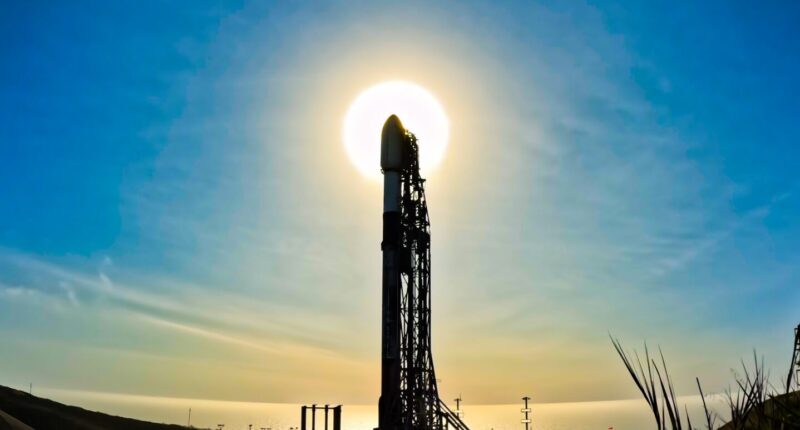A constellation of classified defence satellites built by SpaceX is broadcasting a mysterious signal on forbidden frequencies, potentially violating international standards and raising questions about what the secretive $1.8 billion spy network is transmitting.
Satellites associated with the Starshield satellite network appear to be transmitting to Earth’s surface on frequencies between 2025-2110 MHz, which are normally reserved for sending commands from Earth to satellites in space, reports NPR. The use of those frequencies to downlink data runs counter to standards set by the International Telecommunication Union, a United Nations agency that coordinates global radio spectrum use.
Scott Tilley, an amateur satellite tracker in Canada who first spotted the signals, warned that Starshield’s unusual transmissions have the potential to interfere with other scientific and commercial satellites. But the purpose of the transmissions remains unclear.
“Nearby satellites could receive radio-frequency interference and could perhaps not respond properly to commands — or ignore commands — from Earth,” said Tilley.
Starshield is being built under a $1.8 billion contract signed in 2021 with the National Reconnaissance Office, an intelligence agency that manages spy satellites. The network is designed to provide powerful Earth-imaging capabilities that can operate as a swarm in low orbits, enabling the US government to quickly capture continuous imagery of activities on the ground nearly anywhere on the globe.
“No one can hide,” one source told Reuters when describing the system’s potential capability.
The discovery of the unusual signals happened purely by chance. Tilley was monitoring satellites from his home in British Columbia as a hobby when he accidentally triggered a scan of radio frequencies that should have been silent.
“It was just a clumsy move at the keyboard,” said Tilley. “I was resetting some stuff and then all of a sudden I’m looking at the wrong antenna, the wrong band.”
The band of radio spectrum he found himself examining is reserved for uplinking data to orbiting satellites, meaning there should not be any signals coming from space in that range. But Tilley’s experienced eye noticed what appeared to be a signal coming down from the sky.
When Tilley compared his data to a catalogue of observations made by other amateur satellite trackers around the world, an unexpected identification appeared: Starshield.
Tilley has detected signals from 170 of the Starshield satellites so far. All appear in the 2025-2110 MHz range, though the precise frequencies keep shifting, moving around in ways that could prevent outsiders from tracking them.
A US government database of objects in orbit shows several SpaceX missions having deployed satellites that neither the company nor the government have ever acknowledged, according to Reuters. Two sources confirmed those to be prototypes for the Starshield network.
Since May 2024, the National Reconnaissance Office has conducted 11 launches of Starshield satellites. The agency says it has launched more than 200 satellites as part of its proliferated architecture system to facilitate military Earth observations and communications missions. Approximately 12 prototypes were launched since 2020 on SpaceX’s Falcon 9 rockets.
The signal’s purpose remains a mystery. Starshield uses a much lower frequency range that probably only allows for the transmission of data at rates closer to 3G cellular, according to Tilley. He believes the decision to downlink in a band typically reserved for uplinking data could be designed to hide Starshield’s operations.
Kevin Gifford, a computer science professor at the University of Colorado, Boulder, who specialises in radio interference from spacecraft, told NPR another possibility is that SpaceX was taking advantage of a quiet part of the radio spectrum.
“SpaceX is smart and savvy,” said Gifford. It is possible they decided to just “do it and ask forgiveness later.”
The network is intended to consist of large satellites with imaging sensors, as well as relay satellites that pass imaging data and communications across the network using inter-satellite lasers. SpaceX states that Starshield uses high-assurance cryptographic capability to host classified payloads and process data securely.
The Starshield network is part of the intensifying competition between the US and its rivals to become the dominant military power in space. China also plans to start building its own satellite constellations, whilst the Pentagon has warned of space weapon threats from Russia, which could be capable of disabling entire satellite networks.
Starshield aims to be more resilient to attacks from sophisticated space powers, offering the most persistent, pervasive and rapid coverage of activities on Earth.
Tilley said he decided to go public with his discovery because the world’s satellite operators should be aware of what is happening.
“These are objects in classified orbits, which could potentially disturb other legitimate uses of space,” said Tilley.
SpaceX and the US National Reconnaissance Office did not respond to requests for comment.











